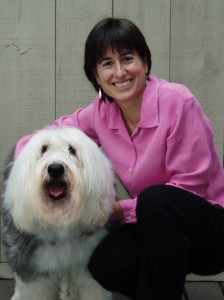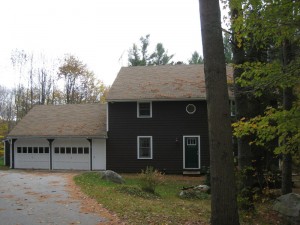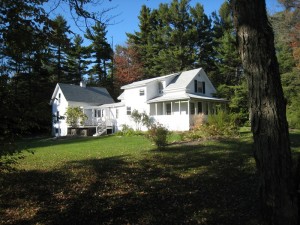Many sellers are tempted to take their homes off the market between Thanksgiving and New Year's. They feel the market significantly slows down and that they have little chance of selling - so why disrupt their holidays? While the slowdown may be true to some degree, there are several advantages for keeping a house on the market during this time frame. First, the buyers that are out looking are serious buyers and are ready to offer on something they like. In addition, there usually are fewer properties on the market this time of year so the competition is reduced. Plus the holidays offer a perfect time to dress up a home for prospective buyers. Sellers looking to sell should seriously consider keeping their home on the market through the holidays - it may turn out to be their most wonderful time of the year!
 Visit my website www.donnaforest.com for more tips on selling your home and give me a call! 603-526-4116
Visit my website www.donnaforest.com for more tips on selling your home and give me a call! 603-526-4116
- Only burn dry, cured wood—logs that have been split, stacked, and dried for eight to 12 months. Cover your log pile on top, but leave the sides open for air flow. Hardwoods such as hickory, white oak, beech, sugar maple, and white ash burn longest, though dry firewood is more important than the species. Less dense woods like spruce or white pine burn well if sufficiently dry, but you’ll need to add more wood to your fire more often, according to CSIA.
- Wood, only wood! Crates, lumber, construction scraps, painted wood, or other treated wood releases chemicals into your home, compromising your air quality. Log starters are fine for getting your fire going, but they burn very hot; generally only use one at a time.
- Close your damper when not using the fireplace to prevent warm indoor air—and the dollars you’re spending to heat it—from rushing up the chimney.
- On a factory-built, prefab wood-burning fireplace, keep bifold glass doors open when burning a fire to allow heat to get into the room.
- Have a chimney cap installed to prevent objects, rain, and snow from falling into your chimney and to reduce downdrafts. The caps have side vents so smoke escapes. A chimney sweep usually provides and can install a stainless steel cap, which is better than a galvanized metal one available at most home improvement retailers because it won’t rust, says Anthony Drago, manager of Ashleigh’s Hearth and Home in Poughkeepsie, N.Y.
- Replace a poorly sealing damper to prevent heat loss. “You can get a top-mounted damper that functions as a rain cap, too, an improvement over the traditional damper because it provides a tighter closure,” says CSIA’s Eldridge.
- Install carbon monoxide detectors and smoke detectors in your house—near the fireplace as well as in bedroom areas.
- If you burn more than three cords of wood annually, get your chimney cleaned twice a year. A cord is 4-feet high, by 4-feet wide, by 8-feet long, or the amount that would fill two full-size pick-up trucks.
- To burn fire safely, build it slowly, adding more wood as it heats and keeping your damper completely open to increase draw in the early stages. Burn the fire hot, at least occasionally—with the damper all the way open to help prevent smoke from lingering the fireplace and creosote from developing.
New Hampshire REALTORS sold 14 percent more homes in October 2011 than in the same period a year ago, marking the fourth consecutive month that unit sales were ahead over the previous year, according to data released by the New Hampshire Association of REALTORS (NHAR). The median price of those homes, meanwhile, decreased by 7 percent in October and are behind year‐to‐date prices of 2010 by 5 percent.
There were 934 residential homes sold in October 2011, a 14 percent increase over the 820 sold in October 2010. That came following jumps of 29 percent, 14 percent and 13 percent in the three months prior. Year to date sales for this year, meanwhile, were 1.5 percent above those through the first 10 months of 2010: 8,960 compared to 8,830.
“There is still too much economic uncertainty to call this a recovery, but we’re certainly beginning to move in the right direction,” said NHAR President Tom Riley, a 35‐year veteran of the real estate industry and president of Riley Enterprises in Bedford. “We would characterize this as the early stages of a gradual stabilization.”
October median price homes dropped from $205,000 in 2010 to $190,000 in 2011. Year to date, the $205,000 median sale price in 2011 is 5 percent below the $215,950 through October of 2010. In local markets, October unit sales increased in seven of 10 counties, while Carroll, Coos and Sullivan counties saw median price increases. October 2011 data residential
As for October condominium sales, there was an almost identical number of statewide sales in 2010 (206) and 2011 (207), while at $169,000 the 2011 median price was 5.7 percent ahead of the$159,900 median price of October 2010. October 2011 data condo
- There are any number of reasons a stove can break, but one common cause of disaster is easy to prevent. Don’t self-clean your oven until AFTER the holidays. You risk blowing a fuse or a thermostat, and tracking down an oven technician around the holidays can be tough.
- Fats and cooking oils can solidify in your pipes, so never dispose of them in your kitchen sink.
- If you have a garbage disposal, make sure it’s running before anything goes in it, and never feed it any stringy, fibrous, or starchy foods like poultry skins or potato peels.
- To fix, don’t rely on chemical drain-clearing products that can harm your pipes. Use a snake instead, available for $15 at your local hardware store. Best to keep one on hand.
- The key to avoiding freezing your party to a standstill is regular maintenance of your HVAC. Every 90 days, a new one-inch pleated furnace filter should be installed. If you haven’t done it in a while, now’s a good time to replace it.
- Also inspect insulation on refrigerant lines that are leading into your house. Replace them if they’re missing or damaged.
- Don’t flush anything other than sewage and toilet paper down the toilet. And there’s nothing wrong with putting up a polite note to remind your guests to do the same.
- Get a thermometer for your refrigerator to make sure each shelf stays below 40 degrees and you can be aware of any temperature changes.
- Also make sure the condenser coils located on the back of the unit or beneath it are free to breathe. Coils blocked from circulating air by cereal boxes atop the fridge, or dirtied by dust or pet hair can prevent a fridge from keeping cool.
Radon is a colorless, odorless, radioactive gas that occurs naturally in the ground from the breakdown of radium. It is very prevalent in New Hampshire. Studies show that high levels of radon increase the risk of lung cancer. Radon enters your home through cracks in the foundation and even from the release of the gas in your water (taking a shower for example). Today's buyers test for radon in the air and water and expect sellers to mitigate levels that are higher than recommended guidelines. Buyers can also use this as a negotiating point to reduce the sales price. For sellers to maximize selling potential, it is best to test before listing and install mitigation systems as needed. This will make the home more saleable and avoid a point of conflict with buyers. In order to better understand radon, contact the State of NH at 721-4764, or give Donna a call for a free state environmental fact sheet on radon, 526-4116.
 Donna Forest, Broker Associate
Donna Forest, Broker Associate
Whether it's this roomy Colonial in New London, or a beautiful post and beam with Lake Sunapee access, we can find the right home for you.
Featured today is 3 bedroom, 3 bath Colonial in a great location only minutes to shopping, the post office, and hospital/medical offices. Nice-sized rooms with open kitchen/family/dining rooms. There is also a detached, large barn/workshop all on 2.4 acres. For more photos and details, visit www.70PineHill.com. Offered at $269,000.
 Marilyn Kidder, Listing Broker
Marilyn Kidder, Listing Broker
603-526-4116
This well-maintained home is adorable and offers a huge great room perfect for entertaining. It's in New London and close to schools, shops and parks. Restored barn. Screened porch and wraparound porch to enjoy the outdoors. 3 bedrooms, 1 bath. Offered at $200,000 and ready to move in!
 Stacey Viandier, Listing Agent
Stacey Viandier, Listing Agent
Incredible value at this price! Two wooded lots with stone walls in back adding a typical touch of New England. Nice neighborhood setting and located on a quiet, dead-end road. Under 7 miles to Mt. Sunapee Ski Resort and about 11 miles to I-89 for commuting. Snowmobile trails nearby for winter fun. Both just under an acre and offered at $28,000 each.
 Donna Forest, Listing Broker
Donna Forest, Listing Broker
 More than one-third of Americans use fireplaces, wood stoves and other fuel-fired appliances as primary heat sources in their homes. Unfortunately, many people are unaware of the fire risks when heating with wood and solid fuels.
More than one-third of Americans use fireplaces, wood stoves and other fuel-fired appliances as primary heat sources in their homes. Unfortunately, many people are unaware of the fire risks when heating with wood and solid fuels.
Heating fires account for 36% of residential home fires in rural areas every year. Often these fires are due to creosote buildup in chimneys and stovepipes. All home heating systems require regular maintenance to function safely and efficiently.
The United States Fire Administration (USFA) encourages you to practice the following fire safety steps to keep those home fires safely burning. Remember, fire safety is your personal responsibility ...Fire Stops With You!
Keep Fireplaces and Wood Stoves Clean
• Have your chimney or wood stove inspected & cleaned annually by a certified chimney specialist.
• Clear the area around the hearth of debris, decorations and flammable materials.
• Always use a metal mesh screen with fireplaces. Leave glass doors open while burning a fire.
• Install stovepipe thermometers to help monitor flue temperatures.
• Keep air inlets on wood stoves open, and never restrict air supply to fireplaces. Otherwise you may cause creosote buildup that could lead to a chimney fire.
• Use fire-resistant materials on walls around wood stoves.
Safely Burn Fuels
• Never use flammable liquids to start a fire.
• Use only seasoned hardwood. Soft, moist wood accelerates creosote buildup.
• Build small fires that burn completely and produce less smoke.
• Never burn cardboard boxes, trash or debris in your fireplace or wood stove.
• When building a fire, place logs at the rear of the fireplace on an adequate supporting grate.
• Never leave a fire in the fireplace unattended. Extinguish the fire before going to bed or leaving.
• Soak hot ashes in water and place them in a metal container outside your home.
Protect the Outside of Your Home
• Stack firewood outdoors at least 30 feet away from your home.
• Keep the roof clear of leaves, pine needles and other debris.
• Cover the chimney with a mesh screen spark arrester.
• Remove branches hanging above the chimney, flues or vents.
Protect the Inside of Your Home
• Install smoke alarms on every level of your home. Test them monthly and change the batteries at least once a year. Consider installing the new long life smoke alarms.
• Provide proper venting systems for all heating equipment.
• Extend all vent pipes at least three feet above the roof.

